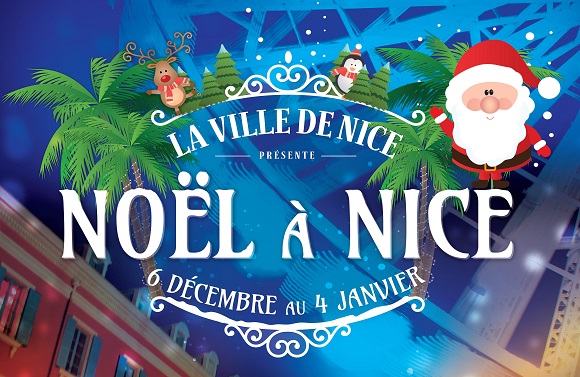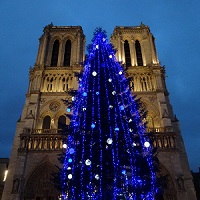
France may be a deeply secular nation, but everyone gets into the spirit of what are called “the end of the year holidays” (les fêtes de fin d’année), meaning Christmas and more.
As the daylight dims and the cool air blows, travelers in France from late November to early January—and beyond in some areas—will find a bright and warm mix of regional, national, commercial and religious traditions throughout the holiday season.
Christmas Eve, rather than Christmas Day, is the privileged family time in France for presents and an abundant dinner, followed for some (relatively few) by midnight mass in some of the country’s magnificent medieval churches and cathedrals. There are then generally leftovers of fine food and drink and, hopefully, family spirit, too, to enjoy on December 25th.
Let’s take a tour of the Christmas season in France through Alsace, Champagne, Lille, Lyon, Provence, Nice and Paris.
(The dates in this article are for the holiday markets and events of 2014 however these are all annual happenings that take place about the same time, give or take a day or two.)
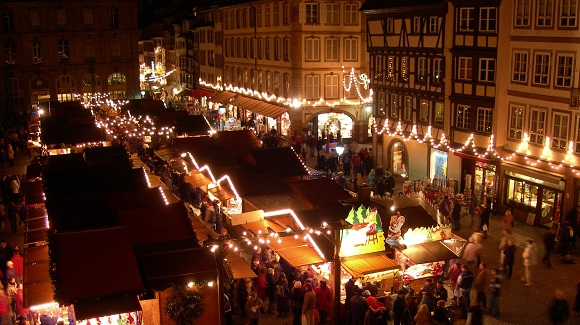
Alsace
One of the most recognizable features of the Christmas season is the Christmas market, rows of chalets (wooden or make-shift shopping huts) set up as early as mid-November in public squares and along major streets to sell folklore, craftsmanship, much food and drink, and Christmas or gift knick-knacks of all kinds.
The tradition of Christmas markets likely originated along the Rhine, leading Strasbourg, which dates the origin of its market to 1570, to call itself “Capital of Christmas.” While otherwise known as capital of Alsace and seat of the European Parliament, Strasbourg pulls out all the stops when it comes to the holiday season.
The most animated of Strasbourg’s Christmas markets surrounds its Notre-Dame Cathedral, whose tremendous steeple dominates the cityscape.
Head due south from Strasbourg and you enter Alsace’s wine route whose bare vines contrast in December with the cheery main streets of picturesque villages, such as Riquewihr and Kaysersberg, that ward off the frost with the warmth of Christmas decorations, mulled wine, gingerbread, small biscuits called bredele and a Bundt-type cake called kouglhof (spelling varies).
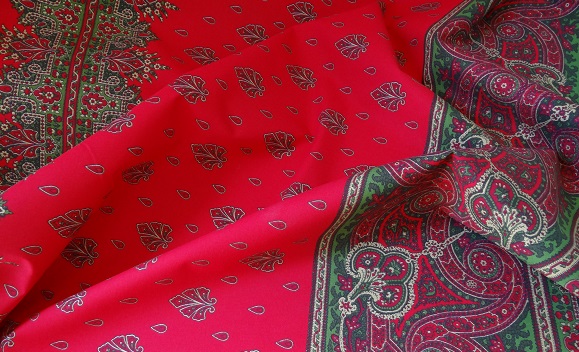
Eventually one reaches Colmar, another hotspot for Christmas markets, and beyond that Mulhouse. Mulhouse, a major player in the European textile industry from the mid-18th to the early 20th centuries, produces each year a new Christmas fabric (this year an adaptation of a late-19th-century motif) that decorates the city and is translated into various derivative products.
For more specifics visit the official tourist information sites of Alsace, Strasbourg, Colmar and Mulhouse.
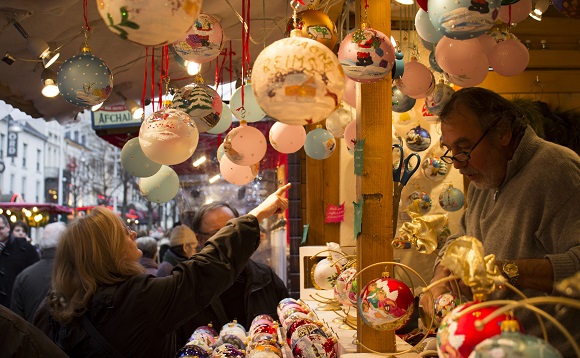
Champagne
Champagne may call to mind the celebration of New Year’s Eve more than Christmas, but Reims, the largest city in the region and home to some of the world’s most elegant champagne houses (i.e. producers) also unfurls an extensive Christmas market along Place Douet d’Erlon, center-city’s main pedestrian drag, and neighboring streets.
The official tourist information site of the city of Reims is found here.

Lille
Lille isn’t quite the North Pole but it’s about as close as one gets while still in France. Never one to miss out on a good party (accompanied by beer rather than wine), Lille gets into the seasonal spirit at its two central square: Place Rihour, which is transformed into an 80-chalet village from Nov. 19 to Dec. 30, and Grand’Place , where a 59-foot pine stands along with a Ferris wheel offering a view over the city. The market fills the square from Nov. 19 to Dec. 30. See Lille’s official Christmas market site here.
Lyon
Lyon’s dazzling Festival of Lights (Fête des Lumières) isn’t directly related to Christmas but nothing announces the winter holiday season better than long nights brightly lit. From December 5 to 8, France’s third largest city is lit by more than 70 different major creative light installations, a brilliant event that draws the oohs and ahhs of 4 million visitors.
For more about Lyon’s Festival of Lights see here.

Provence
North Americans sometimes have trouble associating Christmas with warmer climes since our own Christmas decorative and culinary traditions are rather Alsatian-Germanic in nature. But the nativity story takes place in a bald Mediterranean landscape whose white stone hills have more in common with Provence. In fact, some of world’s must ancient Christian traditions developed in Provence.
While Americans fully enter the Christmas season the day after Thanksgiving, Provence tradition would have it last from the Feast Day of Saint Barbara (Sainte Barb) on Dec. 4 to Candlemas (Chandeleur) on Feb. 2. According to legend, if one plants a plate of wheat at home on Dec. 4 and if by Dec: 25 it grows to a healthy green tuft then abundance will follow in the next harvest. As to Feb. 2, a date Americans are more likely to think of this as Groundhog Day, that’s Candlemas on the Catholic calendar, commemorating the purification of Mary after childbirth and the presentation of Jesus in the Temple. That’s the date when crèches are taken down.
Where better to consider Christmas in Provence than in Avignon, the town that the Catholic Popes called home during through most of the 14th century, when they temporarily abandoned squabble-ridden Rome. One of southern France’s most expansive Christmas markets takes place (this year Nov. 30-Jan. 4) on Avignon’s main square, Place de l’Horloge, around the corner from the Popes’ Palace, the town’s major tourist attraction. Among the many manger scenes set up around town, one of the most outstanding typically occupies a portion of the lobby in City Hill, which is also on Place de l’Horloge.

Beginning about the third week in November, crèches begin to be set up in villages and cities throughout the region. And in those crèches you’ll find dozens of figurines called santons. Santon comes from the Provencal word santou, meaning little saint, though few of these figures are now sainted. Santons of the holy family are naturally central to the crèche, but the vast majority of them represent characters of folklore and everyday life in the ideal, traditional Provencal village. While traditionally made of clay and hand painted, other materials such cardboard, cork, or even paper are used by some santonniers, as their creators are known. These cute, naïve and/or humorous figures are typically thumb-size, so taking a dozen home in your suitcase is no problem. Doll-size and baby-thumb-size santons also exist.
Santons are so anchored in Provence that shops sell them year-round, but to buy them in the Christmas spirit the best place may well be Marseille, where they’re said to have originated. Since 1803 Marseille has its Foire aux Santons, an annual traditional nativity fair where santons and other crèche features can be bought. This year’s fair will be held Nov. 15 to Dec. 31. Aix-en-Provence has had its own santon fair since 1934 (this season Nov. 20-Dec. 31), Arles has been celebrating all things crèche since 1958 (this season Nov. 15 to Jan. 12) and the small town of Carpentras also has a nice market for these precious figurines.
In Avignon as well as in other crèche-proud towns of France, one can follow a special route (le Chemin des crèches) to discover different animated and illuminated nativity scenes. Other regions also have crèche-routes outlined though villages, so don’t hesitate to inquire about crèche routes wherever you may travel during the holiday season. Whether travelers partake in it or not, they’re certain to hear along the way about the Provencal tradition of the 13 desserts of Christmas, which ends the Christmas Eve meal known the big supper (le gros souper). The desserts, numbering 13 in honor of Jesus and the 12 Apostles, consist of dried fruit and nuts, fresh fruit and sweets.
For further details about the above-mentioned towns and cities see the official tourist information sites of Avignon, Marseille, Aix-en-Provence, Arles and Carpentras.
Nice
Though the Riviera holds back on its winter exuberance until the February Carnival/Mardi Gras season, Nice hosts the largest Christmas village of the coast west of Marseille. From Dec. 6 to Jan. 4, Place Massena is given over to 60 chalets, a skating rink and lights galore, while concerts and other events are held on Place Garibaldi on weekend and school holidays. See here for official tourist information about Nice.
Paris
There’s no sweeter place to hunt for Christmas pastries than Paris, where you’ll find some of the best traditional and creative yule logs or buches de Noël, feasts for the eyes as well as for the mouth. The yule log is a log-shaped cake traditionally made of sponge-type cake and chocolate buttercream and then more cream. They can be found throughout France, but their greatest expression graces the fine pastry shops and tea rooms of Paris, where now anything goes as long as it’s got the general shape of a log and a gazillion calories. Though most come in family-size versions, the solitary or coupled traveler will find single or double portions as well.
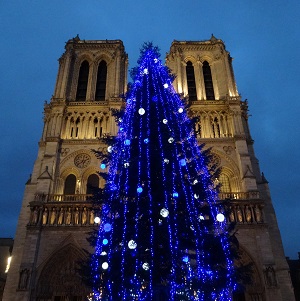
As a whole, Paris doesn’t display the same seasonal fervor as, say, New York, but its major department stores take to the holiday spirit as eagerly as anywhere. This is particularly the case at the department stores Printemps and Galeries Lafayette, behind the Garnier Opera on Boulevard Haussmann, where families and shoppers (or gawkers) of all ages come to admire the year’s display of lights and window dressings.
The City of Light itself has Christmas markets at the bottom of the Champs-Elysées near Place de la Corcorde (Nov. 15-Jan. 5), at the Montparnasse Train Station (Dec. 4-31), Trocadéro, outside Saint-Sulpice Church (Dec. 1-24) and Saint-Germain-des-Prés Church (Dec. 6-Jan. 2) and in Montmartre (Dec. 5-Jan. 4), as well as the town of Versailles (Dec. 5-26) and other near suburbs. The English version of the official Paris information site is found here.
Bonnes fêtes de fin d’année!
© 2014, Gary Lee Kraut
A slightly different version of this article also appears in the Nov.-Dec. 2014 issue of Travelworld International magazine


